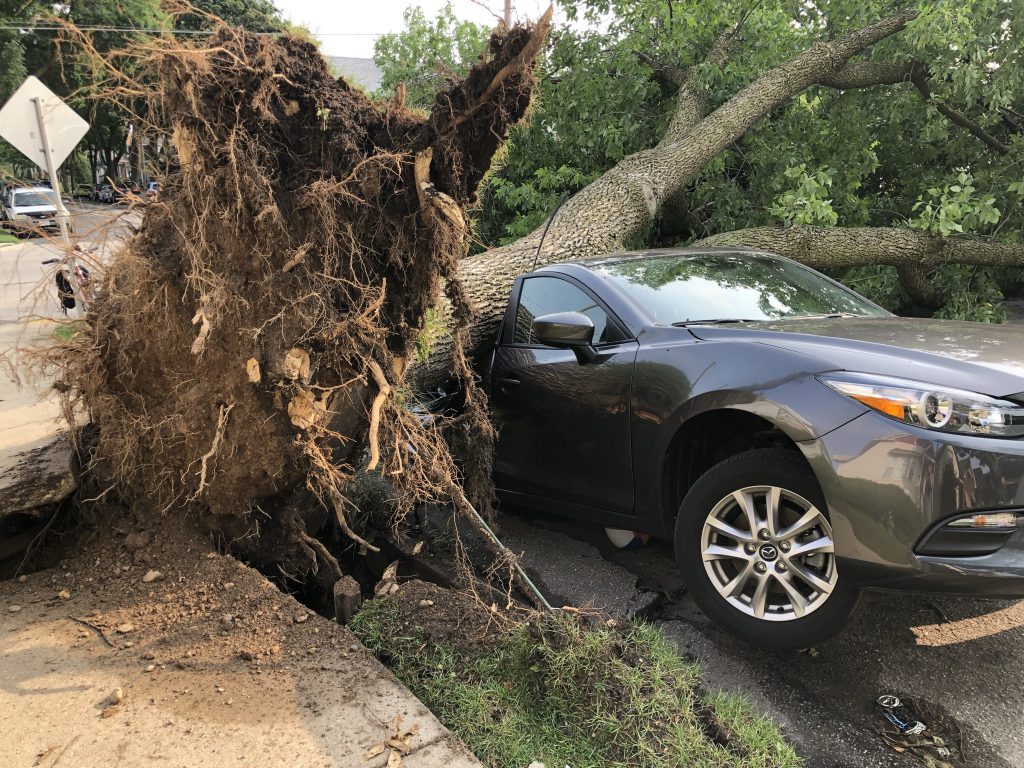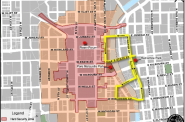More Than 660 Street Trees Lost in August Storm
City officials debating how to get ready for next big storm as they await bill from "unprecedented" event.
“The Aug. 10 storm, I would like to call it unprecedented,” said Department of Public Works forestry services manager Randy Krouse on Thursday to members of the Common Council’s Public Works Committee.
But members of the Common Council think the storm, which brought sustained, horizontal wind at 40 miles per hour, or others like it, could happen again.
Krouse said the storm toppled 660 street trees (out of 189,000), damaged at least 153 buildings and triggered more than 3,000 calls for service. More than 100,000 We Energies customers, including those outside of the city, lost power. Saturated soil produced by a wave of rain in the preceding two weeks, is believed to have contributed to so many trees falling around the city.
“These kinds of winds are going to take down trees, whether they are weakened or strong, healthy trees,” said Krouse. He said DPW crews have now cleared 93% of the city of debris. Their work was focused on the most afflicted area first, between Capitol Drive and Layton Avenue.
DPW reports spending $269,425 on the cleanup effort, an amount which Krouse said will grow significantly as more data is collected. It also excludes any private costs, which includes situations like when a private tree in someone’s backyard falls on their house.
And while the cleanup is still ongoing, city leaders are debating how to get ready for the next issue. Ideas include using federal funds to buy large generators, changing the city’s zoning code and petitioning We Energies to better protect its infrastructure.
Backup Generators
The Milwaukee Water Works continues to invest in emergency readiness.
“We have worked with We Energies in the past to ensure that there are two lines going to our most critical facilities,” said Superintendent Karen Dettmer. But the effort didn’t stop there.
The city-owned utility got a feel last month for how it can respond to an outage at a non-mission critical facility. The storm disabled power to its water meter shop at 2919 W. Cameron Ave. for two days.
The reliability of water service came to the forefront last winter in Texas when more than 12 million residents received a boil water notice because water utilities had temporarily gone offline after losing power.
Thomas Tarkowski, engineer in charge of bridges and buildings, said a number of other city buildings have backup generators that can run some or all of their operation. That includes the City Hall complex, which includes the Zeidler Municipal Building and the 809 N. Broadway office building, the Milwaukee Health Department lab and all but one fire station.
A Backup Government Facility?
Alderman Scott Spiker asked about a backup facility for the city government, referencing that he believed it was to be the Robert Anderson Municipal Building located in his district.
But Dettmer, referencing the extensive documentation process that was undertaken for the Democratic National Convention, cautioned against too much public discussion of such plans.
“Be assured we will tell you where to go,” she said.
But Coggs said she wanted to think beyond terrorism and see more preparation for natural disaster readiness. “Well it seems like some of that is happening, there are gaps that are missing,” she said.
She brought up a situation where a senior was stuck on the third floor of an assisted living facility because the elevators had no power.
“I would agree there are always lessons to be learned,” said Public Works Commissioner Jeff Polenske.
Bauman asked if the city-owned Housing Authority of the City of Milwaukee buildings had backup generators. Neither Tarkowski or Polenske knew. Same for Milwaukee Public Schools facilities, which Bauman said were logical gathering places in the event of a widespread, sustained power outage like that currently seen in New Orleans.
Where is We Energies?
The discussion at multiple points moved back to the entity not in the room — We Energies.
“We have to be able to exist and function without We Energies,” said Bauman. “They are accountable to nobody. Can’t call them. Can’t fire them.”
But Polenske and DPW operations director Danielle Rodriguez said the private electrical utility was a participant in a virtual emergency operations center alongside the police, fire, health, Milwaukee County Department of Transportation and city and county offices of emergency management.
“I know their script,” he said, while expressing frustration that he can call other city departments when a constituent complains, but not the utility. He said he was focused on having the City be able to avoid relying on the utility and, eventually, constituents through personal power generation.
“In the mean time we have reality to deal with,” said Spiker. He said the council could use the levers afforded to it by its bully pulpit. “I suggest we not be shy about pulling them.”
Beyond providing electrical and gas service, the utility must disable power to any downed wires before the city can clear nearby downed trees.
While Bauman and other council members pushed on the issue, Krouse and others were unable to provide specific figures on how much of a delay was incurred because the city can’t turn off the power itself.
In general, Krouse indicated it wasn’t a major source of delay. “A small amount had wires involved, so we were able to act pretty quickly,” said the forestry expert. He said most of the critical work was completed in seven days.
Policy Changes
Short of going to the Public Service Commission and asking for We Energies to better prepare its infrastructure for storms, Bauman and other councils have ideas about how to prepare the city for bigger and bigger storms.
Another idea, and one Bauman said he would advance at a future meeting, is to change the city’s zoning code to require backup generators on new buildings. The policy would ensure that large buildings have functional elevators and other egress equipment.
But no one from the City Attorney’s office was immediately available to opine whether the city had standing to demand We Energies improve its infrastructure or to require generators in its zoning code.
Political Contributions Tracker
Displaying political contributions between people mentioned in this story. Learn more.

























Trees in the forest don’t pull out of the ground by the roots during wind storms like trees in the city. Trees in the forest have long root systems that stretch out from the trunk as far as the drip line of the canopy.
The trees that toppled over in Milwaukee did not have a healthy root system to support the 80-120 feet of massive growth above ground. There’s too much concrete and asphalt covering tree roots in the city. Plant smaller tree species in Milwaukee.
Some German villages have streets lined with pear trees, apple trees, cherry trees, and plum trees.